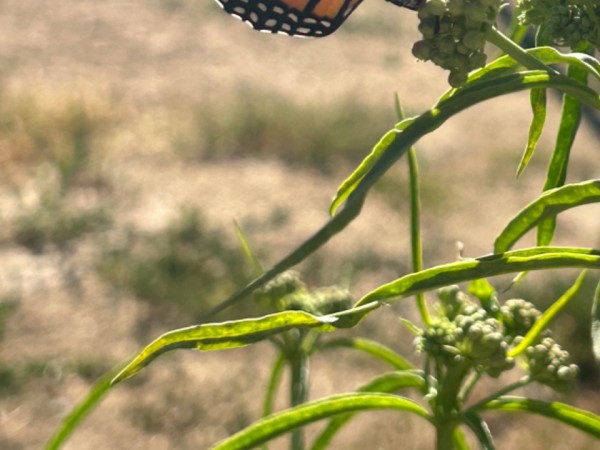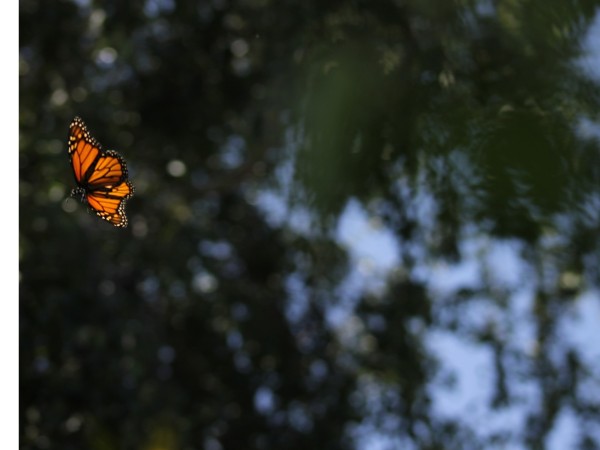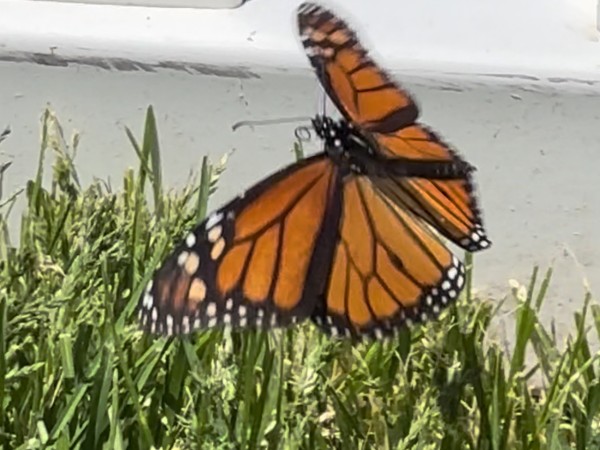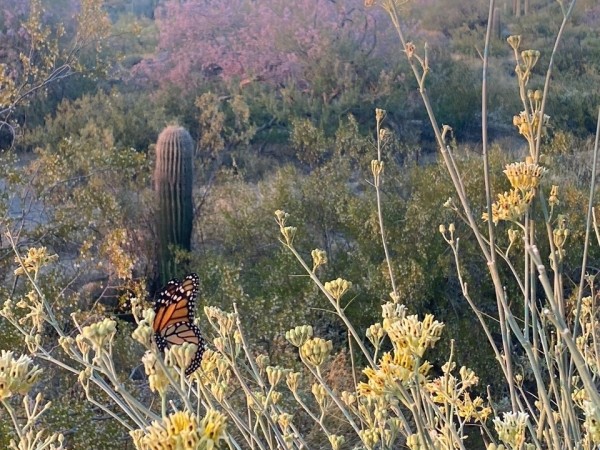Spring migration update #7: Western monarch population news from Gail Morris
We wait. Monarchs who overwintered and left on their spring migration have reached the end of their lives. The next generation nestled in their chrysalises are just about to eclose. Monarch sightings are typically low but we expect them to increase soon, as the first generation’s bright colored wings appear across the Western landscapes. Hope is in the air as we wait for them to appear.
Recent Monarch Sightings
Monarchs this week were mainly in California but soon documented sightings should appear in Nevada, Utah and Oregon in good numbers as the weather conditions are favorable.
Gina in Chula Vista, California, reported 8 monarchs on May 14: “I didn’t get a picture of them all because I didn’t know about reporting sightings … I planted many flowers and I have quite a few fruit trees in my yard and I’ve been seeing many Monarchs for about a week or so.”
Gloria in Lakeside, California, found one monarch on May 18. “Laying eggs all over my narrow leaf milkweed in my yard. She spent over 15 mins coming back and laying eggs, it was windy but she persisted! 2 year old milkweed plant, in flower.”
Further north in Oakland, California, Duncan saw one monarch on May 19. “Flying. Looked healthy. Strong colors.”
In Stockton, California, just east of San Francisco and Oakland, Cynthia wrote on May 21, “Last year my first Monarch sighting was 05/27; today is my first sighting for this year and I'm so excited. I have been watching for weeks now. This male (I think) spent at least 3 hours, from 4:30 when I arrived home, through 7:30 p.m., circling my butterfly bush. He fed only briefly, but mainly seemed to be acquainting himself with our Stockton CA front yard. I attempted many photos but he was so busy, this is the most clear.”
One Journey North report so far this season has been received from Utah, from Christi in Lehi, who wrote on May 21, “I was so excited to see this guy in my yard! I’ve worked hard the last 2 years creating gardens of milkweed and pollinating flowers. Seeing him made it all worth it!”
From the Field
We often think of California this time of year as we hope to have signs of new activity in the monarch population. But Arizona also has occasional “first sightings” of monarchs this time of year as well. While some arrive in late March or early April from Mexico or perhaps the Baja California region, in many years we see a second small surge of monarchs in May. While earlier monarchs use a variety of milkweeds to lay their eggs, many of these May fliers prefer Desert (Rush) Milkweed, Asclepias subulata. Many people groan when they hear of our hot desert summer temperatures, but A. subulata loves our heat and is a common desert perennial that grows best in full sun. Unlike many milkweeds, A. subulata is an evergreen – it doesn’t die back in the winter months. It is also a succulent that is water thrifty, not too surprising since it thrives in a land of little rainfall.
Like many gardeners who love pollinators and monarchs, we have many milkweeds in our city backyards and monarchs usually visit all of them. But in May, monarchs that arrive late in our Spring season on their way to the upper elevations of the state, primarily favor the Desert (Rush) Milkweed. Two weeks ago, my husband, Bob, was waiting in the car for me and when I arrived, he quickly pointed and said, “Look! Look at the milkweed – my first monarch of Spring!” A male monarch was dancing joyfully all around the row of A. subulata in flower. We watched as he flew over and under, sideways zooming quickly and back, over and over again.
Two days later, I was working in the garden in our backyard and looked up to see a female monarch had arrived and was laying eggs all over a large Desert Milkweed plant a short distance away! How could she refuse all the other milkweeds around the yard in full flower and waiting?!!!
I thought our little May monarch surge might be over but then Don Pike sent in pictures of a monarch that just visited his yard this past weekend. Once again, Desert Milkweed was the chosen favorite. Don lives on the border of the City of Mesa and the Tonto National Forest. What a treat to see these late monarchs fly through!
Why is a milkweed that is leafless much of the year until soft ephemeral leaves appear just as the migration comes through such a favorite in May? Earlier researchers found monarchs covered the A. subulata along western Mexico near Baja laying eggs as they flew north each spring. Maybe a few still follow this flight path and do the same? Maybe these are first-generation monarchs hurrying to get to the higher elevations of Arizona out of their desire to evade sizzling first 100-degree temperatures in the desert? So many questions and still few answers. Perhaps it will remain a mystery – at least for now.
Send in your reports!
We need your monarch sightings! Monarch numbers are usually sparse this time of year as they lay eggs increasing the population on their migration to the summer breeding grounds. If you are lucky enough to see a monarch, please report your sighting of any adult, eggs or larvae to Journey North. Your detailed description of what you see can include, but is not limited to, the monarch’s gender and activity. If known, include the type of flowers if they are nectaring or milkweed type if laying eggs. We also encourage you to report milkweed up! Photos encouraged and welcomed with all your reports.
Gail Morris is the Coordinator of the Southwest Monarch Study (www.swmonarchs.org and the Western Monarch Advocates. She is also a Monarch Watch Conservation Specialist, and the Vice President of the Central Arizona Butterfly Association. The Western Monarch Population News is based on comments provided to Gail Morris. We hope to increase the number of sightings and therefore photos and comments entered into Journey North. We rely on the volunteers who communicate regularly with Gail and who agree to participate in our effort to increase awareness of the population of western Monarchs. You can reach her at gail@swmonarchs.org





